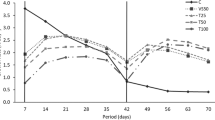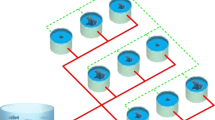Abstract
Intensive fish farming discharges large amount of nutrients, the majority of which are composed of dissolved nitrogen in ammonium form, which promotes eutrophication in coastal waters. Macroalgae have been proven to effectively reduce the nutrients of fish farm effluents and at the same time increase the economic output of the aquaculture system when economically important species are utilized. In this study, the potential of three high value carrageenophytes (Kappaphycus alvarezii, Kappaphycus sp., K. striatum) to extract ammonium in fish farm effluent collected from a milkfish (Chanos chanos) fish cage was investigated. To establish economic viability of the integrated culture system, the effects of elevated total ammonia of fish farm effluent on the growth rate, phycocolloid content, and quality of these seaweeds were determined. Tank cultivation trials showed that the three carrageenophytes substantially reduced the ammonium content of the fish farm effluent (41–66% reduction efficiency) and consequently attained maximum daily growth rates of 4.41%, 2.90%, and 2.75% for K. striatum, Kappaphycus sp., and K. alvarezii, respectively. Their carrageenan content was improved. Carrageenan quality, however, was not significantly enhanced. Elevated ammonium in fish farm effluent did not adversely affect the performance of tank cultivated Kappaphycus; thus, future integration of these seaweeds in fish farms is feasible.





Similar content being viewed by others
References
Araño KG, Trono GC Jr, Montaño NE, Hurtado AQ, Villanueva RD (2000) Growth, agar yield and quality of selected agarophyte species from the Philippines. Bot Mar 43:517–524
Bird KT, Hanisak MD, Ryther J (1981) Chemical quality and production of agars extracted from Gracilaria tikvahiae grown in different nitrogen enrichment conditions. Bot Mar 24:441–444
Buschmann AH, Troell M, Kautsky N, Kautsky L (1996) Integrated tank cultivation of salmonids and Gracilaria chilensis (Gracilariales, Rhodophyta). Hydrobiologia 326/327:75–82
Chopin T, Gallant T, Davison I (1995) Phosphorus and nitrogen nutrition in Chondrus crispus (Rhodophyta): effects on total phosphorus and nitrogen content, carrageenan production, and photosynthetic pigments and metabolism. J Phycol 31:283–293
Chopin T, Buschmann AH, Halling C, Troell M, Kautsky N, Kraemer G, Zertuche-González J, Yarish C, Neefus C (2001) Integrating seaweeds into marine aquaculture systems: a key toward sustainability. J Phycol 37:975–986
Cohen RA, Fong P (2004) Nitrogen uptake and assimilation in Enteromorpha intestinalis (L.) Link (Chlorophyta): using 15N to determine preference during simultaneous pulses of nitrate and ammonium. J Exp Mar Biol Ecol 309:67–77
Cohen RA, Neori A (1991) Ulva lactuca biofilters for marine fishpond effluents: I. Ammonia uptake kinetics and nitrogen content. Bot Mar 34:475–482
DeBoer JA (1979) Effects of nitrogen enrichment on growth rate and phycocolloid content in Gracilaria foliifera and Neoagardhiella baileyi (Florideophyceae). Proceedings from the International Seaweed Symposium, Science Press, Princeton, NJ, vol 9, pp 263–273
FAO (2005) The state of world fisheries and aquaculture 2004. Food and Agricultural Organization, Rome
Hall POJ, Holby O, Kollberg S, Samuelsson M-O (1992) Chemical fluxes and mass balances in a marine fish cage farm. IV. Nitrogen. Mar Ecol Prog Ser 89:81–91
Hansen HP, Koroleff F (1999) Determination of nutrients. In: Grasshoff K, Kremling K, Ehrhart M (eds) Methods of seawater analysis. Wiley-VCH, Weinheim, Germany, pp 188–193
Harrison P, Hurd C (2001) Nutrient physiology of seaweeds: application of concepts to aquaculture. Cah Biol Mar 42:71–82
Hernández I, Martínez-Aragon JF, Tovar A, Pérez-Lloréns JL, Vergara JJ (2002) Biofiltering efficiency in removal of dissolved nutrients by three species of estuarine macroalgae cultivated with sea bass (Dicentrarchus labrax) waste waters 2. Ammonium. J Appl Phycol 14:375–384
Jacinto GS (2002) Bolinao fish kill—looking back. AQUA Beat, 2:2
Jiménez Del Rio M, Ramazanov Z, García-Reina G (1996) Ulva rigida (Ulvales, Chlorophyta) tank culture as biofilters for dissolved inorganic nitrogen from fishpond effluents. Hydrobiologia 326/327:61–66
Kinne PN, Samocha TM, Jones ER, Browdy CL (2001) Characterization of intensive shrimp pond effluent and preliminary studies on biofiltration. North Am J Aquacult 63:25–33
Li R, Li J, Wu CY (1990) Effect of ammonium on growth and carrageenan content in Kappaphycus alvarezii (Gigartinales, Rhodophyta). Hydrobiologia 204/205:499–503
Lluisma AO (1992) Effects of nitrogen, phosphorus and photon flux density on growth, photosynthesis and proximate constituents in branch cultures of Kappaphycus alvarezii Doty (Doty). MS Thesis, University of the Philippines Diliman, Quezon City, Philippines, p 98
Martinez LA, Buschmann AH (1996) Agar yield and quality of Gracilaria chilensis (Gigartinales, Rhodophyta) in tank culture using fish effluents. Hydrobiologia 326/327:341–345
Msuya FE, Neori A (2002) Ulva reticulata and Gracilaria crassa: macroalgae that can biofilter effluent from tidal fishponds in Tanzania. Western Indian Ocean J Mar Sci 1:117–126
Naylor RL, Goldburg RJ, Primavera JH, Kautsky N, Beveridge MCM, Clay J, Folke C, Lubchenco J, Mooney H, Troell M (2000) Effect of aquaculture on world fish supplies. Nature 405:1017–1024
Neori A, Chopin T, Troell M, Buschmann AH, Kraemer GP, Halling C, Shpigel M, Yarish C (2004) Integrated aquaculture: rationale, evolution and state of the art emphasizing seaweed biofiltration in modern mariculture. Aquaculture 231:361–391
Neori A, Shpigel M, Ben-Ezra D (2000) A sustainable integrated system for culture of fish, seaweed and abalone. Aquaculture 186:279–291
Neori A, Ragg NLC, Shpigel M (1998) The integrated culture of seaweed, abalone, fish and clams in modular intensive land-based systems: II. Performance and nitrogen partitioning within an abalone (Haliotis tuberculata) and macroalgae culture system. Aquacult Eng 17:215–239
Obliosca JM, Jacinto GS, San Diego-McGlone ML (2003) Preliminary results on the development of marine environmental quality criteria for mariculture areas. Philipp Scient 40:73–87
Qian P-Y, Wu CY, Xie YK (1996) Integrated cultivation of the red alga Kappaphycus alvarezii and the pearl oyster Pinctada martensi. Aquaculture 147:21–35
Schuenhoff A, Shpigel M, Lupatsch I, Askenazi A, Msuya FE, Neori A (2003) A semi-recirculating, integrated system for the culture of fish and seaweed. Aquaculture 221:167–181
Stanley NF (1990) Carrageenans. In: Harris P (ed) Food gels. Elsevier Science, New York, pp 79–119
Troell M, Halling C, Neori A, Chopin T, Buschmann AH, Kautsky N, Yarish C (2003) Integrated mariculture: asking the right questions. Aquaculture 226:69–90
Troell M, Halling C, Nilsson, Buschmann AH, Kautsky N, Kautsky L (1997) Integrated marine cultivation of Gracilaria chilensis (Gracilariales, Rhodophyta) and salmon cages for reduced environmental impact and increased economic output. Aquaculture 156:45–61
Troell M, Rönnback P, Halling C, Kautsky N, Buschmann A (1999) Ecological engineering in aquaculture: use of seaweeds for removing nutrients from intensive mariculture. J Appl Phycol 11:89–97
Trono GC Jr (1992) Eucheuma and Kappaphycus: taxonomy and cultivation. Bull Mar Sci Kochi University, Japan, 12:51–65
Villanueva RD, Montaño MNE (2003) Fine chemical structure of carrageenan from the commercially cultivated Kappaphycus striatum (sacol variety) (Solieriaceae, Gigartinales, Rhodophyta). J Phycol 39:513–518
Wu RSS (1995) The environmental impact of marine fish culture: towards a sustainable future. Mar Pollut Bull 31:159–166
Acknowledgements
This study was partially supported by a thesis grant from the University of the Philippines (OVCRD Grant No. 014414 TNSE) to M.R. Rodrigueza. We gratefully acknowledge Dr. R. Villanueva for his valuable comments which significantly improved the manuscript. We also thank M. Ponce, O. Olivar and E. Balbin for their assistance in the field and hatchery work and extraction of carrageenan, respectively. The UP-MSI Bolinao Marine Laboratory is likewise acknowledged for allowing the use of the hatchery facility. This is MSI contribution No. 356.
Author information
Authors and Affiliations
Corresponding author
Rights and permissions
About this article
Cite this article
Rodrigueza, M., Montaño, M. Bioremediation potential of three carrageenophytes cultivated in tanks with seawater from fish farms. J Appl Phycol 19, 755–762 (2007). https://doi.org/10.1007/s10811-007-9217-0
Received:
Revised:
Accepted:
Published:
Issue Date:
DOI: https://doi.org/10.1007/s10811-007-9217-0




